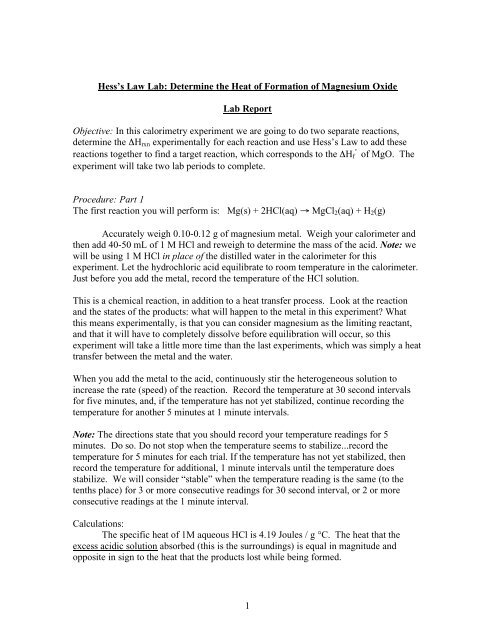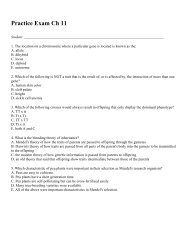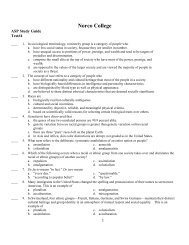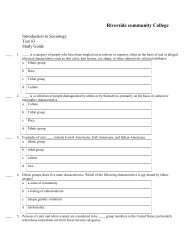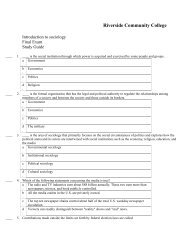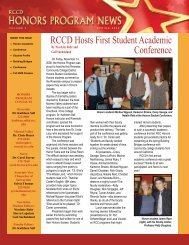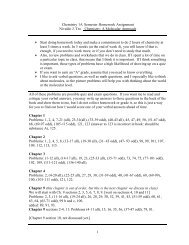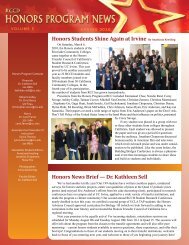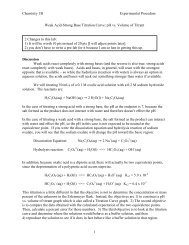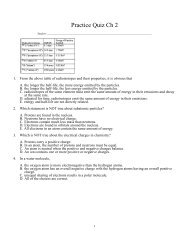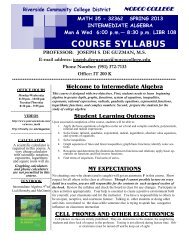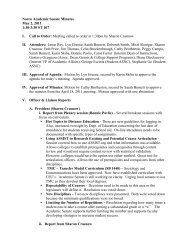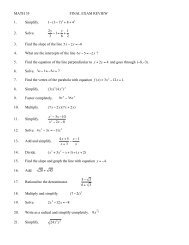1 Hess's Law Lab: Determine the Heat of Formation of Magnesium ...
1 Hess's Law Lab: Determine the Heat of Formation of Magnesium ...
1 Hess's Law Lab: Determine the Heat of Formation of Magnesium ...
- No tags were found...
Create successful ePaper yourself
Turn your PDF publications into a flip-book with our unique Google optimized e-Paper software.
Hess’s <strong>Law</strong> <strong>Lab</strong>: <strong>Determine</strong> <strong>the</strong> <strong>Heat</strong> <strong>of</strong> <strong>Formation</strong> <strong>of</strong> <strong>Magnesium</strong> Oxide<strong>Lab</strong> ReportObjective: In this calorimetry experiment we are going to do two separate reactions,determine <strong>the</strong> H rxn experimentally for each reaction and use Hess’s <strong>Law</strong> to add <strong>the</strong>sereactions toge<strong>the</strong>r to find a target reaction, which corresponds to <strong>the</strong> H f°<strong>of</strong> MgO. Theexperiment will take two lab periods to complete.Procedure: Part 1The first reaction you will perform is: Mg(s) + 2HCl(aq) MgCl 2 (aq) + H 2 (g)Accurately weigh 0.10-0.12 g <strong>of</strong> magnesium metal. Weigh your calorimeter and<strong>the</strong>n add 40-50 mL <strong>of</strong> 1 M HCl and reweigh to determine <strong>the</strong> mass <strong>of</strong> <strong>the</strong> acid. Note: wewill be using 1 M HCl in place <strong>of</strong> <strong>the</strong> distilled water in <strong>the</strong> calorimeter for thisexperiment. Let <strong>the</strong> hydrochloric acid equilibrate to room temperature in <strong>the</strong> calorimeter.Just before you add <strong>the</strong> metal, record <strong>the</strong> temperature <strong>of</strong> <strong>the</strong> HCl solution.This is a chemical reaction, in addition to a heat transfer process. Look at <strong>the</strong> reactionand <strong>the</strong> states <strong>of</strong> <strong>the</strong> products: what will happen to <strong>the</strong> metal in this experiment? Whatthis means experimentally, is that you can consider magnesium as <strong>the</strong> limiting reactant,and that it will have to completely dissolve before equilibration will occur, so thisexperiment will take a little more time than <strong>the</strong> last experiments, which was simply a heattransfer between <strong>the</strong> metal and <strong>the</strong> water.When you add <strong>the</strong> metal to <strong>the</strong> acid, continuously stir <strong>the</strong> heterogeneous solution toincrease <strong>the</strong> rate (speed) <strong>of</strong> <strong>the</strong> reaction. Record <strong>the</strong> temperature at 30 second intervalsfor five minutes, and, if <strong>the</strong> temperature has not yet stabilized, continue recording <strong>the</strong>temperature for ano<strong>the</strong>r 5 minutes at 1 minute intervals.Note: The directions state that you should record your temperature readings for 5minutes. Do so. Do not stop when <strong>the</strong> temperature seems to stabilize...record <strong>the</strong>temperature for 5 minutes for each trial. If <strong>the</strong> temperature has not yet stabilized, <strong>the</strong>nrecord <strong>the</strong> temperature for additional, 1 minute intervals until <strong>the</strong> temperature doesstabilize. We will consider “stable” when <strong>the</strong> temperature reading is <strong>the</strong> same (to <strong>the</strong>tenths place) for 3 or more consecutive readings for 30 second interval, or 2 or moreconsecutive readings at <strong>the</strong> 1 minute interval.Calculations:The specific heat <strong>of</strong> 1M aqueous HCl is 4.19 Joules / g °C. The heat that <strong>the</strong>excess acidic solution absorbed (this is <strong>the</strong> surroundings) is equal in magnitude andopposite in sign to <strong>the</strong> heat that <strong>the</strong> products lost while being formed.1
Q excess HCl aqueous soln (surroundings) = -Q Mg+2HCl MgCl2 + H2 (system)Since this is true, <strong>the</strong> next equation is also true:Q soln = m soln c soln T soln = -Q rxn = - (m rxnc rxnT rxn)and som soln c soln T soln = - (m rxnc rxnT rxn)• Calculate <strong>the</strong> heat absorbed by <strong>the</strong> surrounding solution in each trial <strong>of</strong> yourexperiments, and this will also determine <strong>the</strong> change in enthalpy <strong>of</strong> <strong>the</strong> reaction that youjust completed (see <strong>the</strong> equations above).• Then determine <strong>the</strong> molar heat <strong>of</strong> reaction: how much heat would be lost if your startinglimiting reactant were one mole?• Check to see if your two answers are within five percent <strong>of</strong> each o<strong>the</strong>r. Ask <strong>the</strong>instructor if you do not know how to do this.• Check your answers with <strong>the</strong> instructor before doing a third trial to see if you are on <strong>the</strong>right track.Procedure: Part 2The reaction for this part isMgO(s) + 2HCl(aq) MgCl 2 (aq) + H 2 O(l)The procedure is <strong>the</strong> same, but with different quantities <strong>of</strong> materials.Accurately weigh 0.3-0.4 g <strong>of</strong> magnesium oxide metal. Weigh your calorimeter and <strong>the</strong>nadd 30 mL <strong>of</strong> 1 M HCl and reweigh to determine <strong>the</strong> mass <strong>of</strong> <strong>the</strong> acid. While allowingThought Question: The experiment is <strong>the</strong> same, but <strong>the</strong> quantities <strong>of</strong> materials are different.What does this tell you about <strong>the</strong> magnitude (how large <strong>the</strong> number is) <strong>of</strong> <strong>the</strong> heat lost in<strong>the</strong> first reaction compared to <strong>the</strong> heat lost in <strong>the</strong> second reaction?<strong>the</strong> solution to equilibrate, use your spatula to pulverize any lumps in <strong>the</strong> magnesiumoxide powder. Lumps are tightly compacted powder, and this decreases <strong>the</strong> surface area<strong>of</strong> <strong>the</strong> substance available for reaction.Aside: [This is also true in baking. Sometimes corn starch or baking powder is socompacted that most <strong>of</strong> <strong>the</strong> substance doesn’t even react, and so you get tiny white(uncooked) lumps in your cake or pancake or muffins. This is why chefs sift <strong>the</strong> dryingredients, to make sure that all <strong>of</strong> <strong>the</strong> ingredients are fine powders, ensuring that <strong>the</strong>ywill react completely.]2
When more surface area is available, <strong>the</strong> reaction will occur faster. The faster <strong>the</strong>reaction occurs, <strong>the</strong>n <strong>the</strong>re is less time for heat to be lost to <strong>the</strong> environment; thus, yourexperiment will be more accurate.When you add <strong>the</strong> metal oxide to <strong>the</strong> acid, continuously stir <strong>the</strong> heterogeneous solution toincrease <strong>the</strong> rate (speed) <strong>of</strong> <strong>the</strong> reaction. Record <strong>the</strong> temperature at 30 second intervalsfor 10 minutes. Check to see if all <strong>of</strong> <strong>the</strong> powder has reacted. If <strong>the</strong> temperature has notyet stabilized, or if <strong>the</strong> powder has not completely reacted, continue recording <strong>the</strong>temperature for ano<strong>the</strong>r 5 minutes at 1 minute intervals until <strong>the</strong> powder has completelyreacted (limiting reactant, again) and until <strong>the</strong> temperature has stabilized. Again, all <strong>of</strong>this data should be recorded! This will be part <strong>of</strong> your observations grade.Repeat this reaction so that you have 3 good trials, or 3 trials that yield a H rxn that arewithin 5% <strong>of</strong> each o<strong>the</strong>r.CalculationsQ excess HCl aqueous soln (surroundings) = -Q MgO+2HCl MgCl2 + H2O (system)• Calculate <strong>the</strong> heat absorbed by <strong>the</strong> surrounding solution in each trial <strong>of</strong> yourexperiments, and this will also determine <strong>the</strong> change in enthalpy <strong>of</strong> <strong>the</strong> reaction that youjust completed (see <strong>the</strong> equations above).• Then determine <strong>the</strong> molar heat <strong>of</strong> reaction: how much heat would be lost if your startinglimiting reactant were one mole?<strong>Lab</strong> ReportObjective: Write an appropriate objective that mirrors <strong>the</strong> main conclusion.Reactions (3)Data Table: - all data taken, but you do not have to include all <strong>of</strong> <strong>the</strong> times-temperaturevalues. You DO need to show <strong>the</strong> initial and equilibrium temperatures. You also need toinclude <strong>the</strong> reference “correct” values given in class, as part <strong>of</strong> your data. Both sets <strong>of</strong>data (data from both reactions) should be in this section; DO NOT set up <strong>the</strong> data as ifthis were two separate lab reports. If you include results in your data table, points will bededucted.Calculations: One sample for each type <strong>of</strong> calculation for EACH reaction.There should be a header for each type <strong>of</strong> calculation, and <strong>the</strong>n a verbal for each type <strong>of</strong>calculation. IF <strong>the</strong> verbal is <strong>the</strong> same for BOTH reactions, <strong>the</strong>n you only need to write itonce. We are half way through <strong>the</strong> semester. You need to follow <strong>the</strong>se instructionsexplicitly. If you want to discuss <strong>the</strong> format with me BEFORE <strong>the</strong> due date <strong>of</strong> <strong>the</strong> report,you can do that through email or <strong>of</strong>fice hours.DO NOT include more than 2 trials per calculation or points will be deducted. Show <strong>the</strong>answers to all 6 trials in <strong>the</strong> results table which is separate from <strong>the</strong> data table, and comes3
after <strong>the</strong> calculations section. Points will be deducted if you format your reportdifferently.Calculations include – again one calculation using Trial 1 data in part 1 and one usingTrial 1 data from part 2:• change in temperatures (T)• heat <strong>of</strong> reaction• molar heat <strong>of</strong> reaction• average molar heat <strong>of</strong> reaction• average deviation• H f°<strong>of</strong> MgCl 2 , kJ/mole (experimental)• % error <strong>of</strong> H f°<strong>of</strong> MgCl 2 , kJ/mole from literature value given in class.• To find <strong>the</strong> H f°<strong>of</strong> MgO, kJ/mole (experimental), use Hess’s <strong>Law</strong>. You willhave gotten your target reaction (H f ° reaction <strong>of</strong> MgO) by <strong>the</strong> end <strong>of</strong> <strong>the</strong> lab.You will need ONE more reaction, which you will be able to figure out, given<strong>the</strong> o<strong>the</strong>r two reactions plus <strong>the</strong> target reaction. You will use <strong>the</strong> text book value(from <strong>the</strong> appendix in <strong>the</strong> text) for this reaction. Using Hess’s <strong>Law</strong> and yourAVERAGE numbers from <strong>the</strong> experimental data for reactions 1 and 2,determine <strong>the</strong> heat <strong>of</strong> reaction <strong>of</strong> <strong>the</strong> target reaction. No credit will be given for“products – reactants” method.• Show <strong>the</strong> complete solution for <strong>the</strong> Hess’s <strong>Law</strong> calculation.• % error <strong>of</strong> H f°<strong>of</strong> MgO, kJ/mole from literature value given in class.Results Table: Put all <strong>of</strong> <strong>the</strong> results (answers to all calculations above) for all 6 trials inthis table. For <strong>the</strong> Hess’s <strong>Law</strong> calculation, just enter <strong>the</strong> one, final H rxn for <strong>the</strong> resultstable, and <strong>the</strong>n <strong>the</strong> % error from <strong>the</strong> literature value.No Graphs.Discussion: Discuss any errors or difficulties from this experiment.Conclusion: Re-state in sentence form, <strong>the</strong> most important results listed in <strong>the</strong> resultstable. The numbers should be stated as “17 “ not “seventeen”. Also, percent errorsassociated with <strong>the</strong> main results should be incorporated in context. (Do not list % errorsseparately, but next to <strong>the</strong> result that each describes).4


